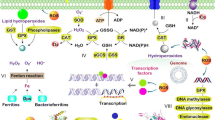Abstract
Mutant spores of Dictyostelium discoideum, strain SG-10, differ from wild type spores in their ability to spontaneously germinate, to be activated with 5% dimethyl Sulfoxide (DMSO), and to be deactivated with 0.2 M sucrose. Both heat-activated wild type and mutant spores began to swell after a lag of 60–75 min at ambient temperature. Suspension of heat activated spores in 5% DMSO resulted in blockage of spore swelling and a concomitant severe inhibition of respiration; removal of 5% DMSO allowed resumption of respiration and the spores began to swell after a lag of only 15 min. It was concluded that 5% DMSO allowed the early reactions (M) to proceed but blocked the later reactions (R) of post-activation lag.
Treatment of one day old spores with 20% DMSO solution for 30–120 min quantitatively activated the population. The post-activation lag time was directly dependent on the time of 20% DMSO treatment. Spores activated with 20% DMSO treatment could be deactivated by incubation at 0°C; the spores most quickly deactivated at 0°C were those within 10 min of swelling. Mitochondrial transport inhibitors such as azide and cyanide caused deactivation in an analogous manner. It is hypothesized that spores proceed to the second portion of the lag phase called (R) before the environment determines if dormancy is reimposed or if germination will proceed. The sensitive strain (SG-10) showed a greater degree of “damage” than the wild type after supraoptimal treatment with 40% DMSO. The spores became more resistant with age to the “damaging” action of 40% DMSO. All the observed effects of DMSO treatment were compatible with our multistate model of activation which suggests that the early portion of the lag phase (M) may involve a relative uncoupling of oxidative phosphorylation while the later portion (R) may require tight coupling.
Similar content being viewed by others
References
Bacon, C. W., Sussman, A. S.: Effects of the self-inhibitor of Dictyostelium discoideum on spore germination. J. gen. Microbiol. 76, 331–344 (1973)
Cavender, J. C., Raper, K. B.: The occurrence and distribution of Acrasieae in forests of subtropical and tropical America. Amer. J. Bot. 55, 504–513 (1968)
Charest, R. P., Cotter, D. A.: Deactivation of Dictyostelium discoideum spores. Abs. Ann. Meeting Amer. Soc. Microbiol., p. 134 (1975)
Conover, T. E.: Influence of organic solutes on the reactions of oxidative phosphorylation. J. biol. Chem. 244, 254–259 (1969)
Conover, T. E.: Influence of nonionic organic solutes on various reactions of energy conservation and utilization. Ann. N.Y. Acad. Sci. 243, 24–37 (1975)
Cotter, D. A.: Heat induced spore germination in Dictyostelium discoideum. Ph. D. thesis, Univ. Wisconsin, Madison (1967)
Cotter, D. A.: Autoinhibition of spore germination in the slime mold Dictyostelium discoideum. Abs. Ann. Meeting Amer. Soc. Microbiol., p. 40 (1973a)
Cotter, D. A.: Spore germination in Dictyostelium discoideum: I. The thermodynamics of reversible activation. J. theor. Biol. 41, 41–51 (1973b)
Cotter, D. A.: Analysis of Dictyostelium discoideum spore dormancy and germination using a mutant with altered activation requirements. Abs. Ann. Meeting Amer. Soc. Microbiol., p. 135 (1975a)
Cotter, D. A.: Spores of the cellular slime mold, Dictyostelium discoideum. In: Spores VI (P. Gerhardt, H. Sadoff, R. Costilow, eds.). Washington: Amer. Soc. Microbiol. 1975b
Cotter, D. A., George, R. P.: Germination and mitochondrial damage in spores of Dictyostelium discoideum following supraoptimal heating. Arch. Microbiol. 103, 163–168 (1975)
Cotter, D. A., O'Connell, R.: Activation of Dictyostelium discoideum spores with dimethyl sulfoxide and urea. Abs. Ann. Meeting Amer. Soc. Microbiol., p. 29 (1974)
Cotter, D. A., Raper, K. B.: Spore germination in Dictyostelium discoideum. Proc. nat. Acad. Sci. (Wash.) 56, 880–887 (1966)
Cotter, D. A., Raper, K. B.: Analysis of heat shock-induced germination in Dictyostelium discoideum. J. Cell Biol. 35, p. 28A (1967)
Cotter, D. A., Raper, K. B.: Factors affecting the rate of heat-induced spore germination in Dictyostelium discoideum. J. Bact. 96, 86–92 (1968a)
Cotter, D. A., Raper, K. B.: Properties of germinating spores of Dictyostelium discoideum. J. Bact. 96, 1680–1689 (1968b)
Cotter, D. A., Raper, K. B.: Spore germination in strains of Dictyostelium discoideum and other members of the Dictyosteliaceae. J. Bact. 96, 1690–1695 (1968c)
Ennis, H. L., Sussman, M.: Mutants of Dictyostelium discoideum defective in spore germination. J. Bact. 124, 62–64 (1975)
Hashimoto, Y.: Effect of radiation on the germination of spores of Dictyostelium. Nature (Lond.) 231, 316–317 (1971)
Hashimoto, Y., Yanagisawa, J.: Effect of radiation on the germination of the cellular slime mold Dictyostelium discoideum. Radiat. Res. 44, 649–659 (1970)
Henderson, T. R., Henderson, R. F., York, J. L.: Effects of dimethyl sulfoxide on subunit proteins. Ann. N.Y. Acad. Sci. 243, 38–53 (1975)
Khoury, A. T., Deering, R. A., Levin, G., Altman, G.: Gammaray-induced spore germination of Dictyostelium discoideum. J. Bact. 104, 1022–1023 (1970)
Norberg, A. M., Raper, K. B.: The Dictyostelium mucoroides complex. Abs. Ann. Meeting Amer. Soc. Microbiol., p. 39 (1972)
Quesnel, L. B., Scott, B. L., Taylor, J. L.: The effect of dimethyl sulfoxide on the survival and germination of Bacillus subtilis spores. In: Spore research 1971 (A. N. Barker, G. W. Gould, J. Wolf, eds.), p. 303. London, England: Academic Press 1971
Sussman, A. S., Halvorson, H. O.: Spores: Their dormancy and germination, p. 354. New York: Harper and Row 1966
Widdowson, J. P.: Bacillus pantothenticus spores activated by dimethyl-formamide and dimethylsulfoxide. Nature (Lond.) 214, 812 (1967)
Author information
Authors and Affiliations
Rights and permissions
About this article
Cite this article
Cotter, D.A., Morin, J.W. & O'Connell, R.W. Spore germination in Dictyostelium discoideum . Arch. Microbiol. 108, 93–98 (1976). https://doi.org/10.1007/BF00425097
Received:
Issue Date:
DOI: https://doi.org/10.1007/BF00425097




